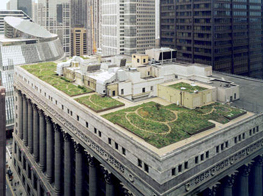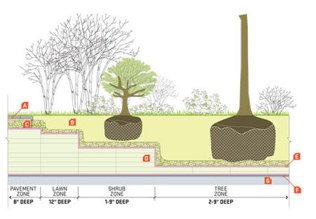Green Roofs
Purposely choosing to live in a city means giving up certain aspects of rural or suburban life, such as less crowded sidewalks, fresher air, friendlier neighbors and the sound of chirping crickets at night. Most noticeably, city living lacks greenery. We trade in front lawns and back yards for measly potted plants on the stoop or windowsill. For those who dream of reclaiming their green thumb or feeling the grass between their toes but are not quite ready to leave city bustle behind, the solution maybe a "green roof."
 A green roof makes use of the wasted space atop buildings to provide the foliage cities lack. Much more than traditional roof gardens, green roofs are a plantable layer of lightweight soil and vegetation (1 to 5 inches deep for extensive types and over a foot deep for intensive types) that covers most or all of the roof surface. The soil absorbs rain water that would otherwise become sewer runoff. The plants filter pollutants and CO2 out of the air and water. Replacing the heat absorbing tar and asphalt roofs not only extends the life of the roof itself, but prevents the “heat island” effect which raises city temperatures by up to 10 degrees. Benefits to all city dwellers increase exponentially as more buildings plant green roofs, and organizations such as Earth Pledge aspire to cover the entire metropolis.
A green roof makes use of the wasted space atop buildings to provide the foliage cities lack. Much more than traditional roof gardens, green roofs are a plantable layer of lightweight soil and vegetation (1 to 5 inches deep for extensive types and over a foot deep for intensive types) that covers most or all of the roof surface. The soil absorbs rain water that would otherwise become sewer runoff. The plants filter pollutants and CO2 out of the air and water. Replacing the heat absorbing tar and asphalt roofs not only extends the life of the roof itself, but prevents the “heat island” effect which raises city temperatures by up to 10 degrees. Benefits to all city dwellers increase exponentially as more buildings plant green roofs, and organizations such as Earth Pledge aspire to cover the entire metropolis.  Individual buildings will benefit from reduced heating and cooling costs, tax incentives and an added oasis residents can escape to. The prospect of having a green roof in your own building is not so far off. Greening Gotham provides standardized letters that you can mail to your own landlord or co-op board to appeal for your own green roof and join the initiative. Sounds of chirping crickets not included.
Individual buildings will benefit from reduced heating and cooling costs, tax incentives and an added oasis residents can escape to. The prospect of having a green roof in your own building is not so far off. Greening Gotham provides standardized letters that you can mail to your own landlord or co-op board to appeal for your own green roof and join the initiative. Sounds of chirping crickets not included.
-----------------------------------
Helen Rubenstein grew up mostly in New York, went to school upstate and now lives in Manhattan. She holds a degree in Design and Environmental Analysis, focused on sustainable interior design. After trying her hand at architecture, she now works for a construction management company. When she is not busy sponsoring PBS and being a makeup mogul (no, not really) she tries to learn something new every day and take advantage of everything the city has to offer.
 A green roof makes use of the wasted space atop buildings to provide the foliage cities lack. Much more than traditional roof gardens, green roofs are a plantable layer of lightweight soil and vegetation (1 to 5 inches deep for extensive types and over a foot deep for intensive types) that covers most or all of the roof surface. The soil absorbs rain water that would otherwise become sewer runoff. The plants filter pollutants and CO2 out of the air and water. Replacing the heat absorbing tar and asphalt roofs not only extends the life of the roof itself, but prevents the “heat island” effect which raises city temperatures by up to 10 degrees. Benefits to all city dwellers increase exponentially as more buildings plant green roofs, and organizations such as Earth Pledge aspire to cover the entire metropolis.
A green roof makes use of the wasted space atop buildings to provide the foliage cities lack. Much more than traditional roof gardens, green roofs are a plantable layer of lightweight soil and vegetation (1 to 5 inches deep for extensive types and over a foot deep for intensive types) that covers most or all of the roof surface. The soil absorbs rain water that would otherwise become sewer runoff. The plants filter pollutants and CO2 out of the air and water. Replacing the heat absorbing tar and asphalt roofs not only extends the life of the roof itself, but prevents the “heat island” effect which raises city temperatures by up to 10 degrees. Benefits to all city dwellers increase exponentially as more buildings plant green roofs, and organizations such as Earth Pledge aspire to cover the entire metropolis.  Individual buildings will benefit from reduced heating and cooling costs, tax incentives and an added oasis residents can escape to. The prospect of having a green roof in your own building is not so far off. Greening Gotham provides standardized letters that you can mail to your own landlord or co-op board to appeal for your own green roof and join the initiative. Sounds of chirping crickets not included.
Individual buildings will benefit from reduced heating and cooling costs, tax incentives and an added oasis residents can escape to. The prospect of having a green roof in your own building is not so far off. Greening Gotham provides standardized letters that you can mail to your own landlord or co-op board to appeal for your own green roof and join the initiative. Sounds of chirping crickets not included.
-----------------------------------
Helen Rubenstein grew up mostly in New York, went to school upstate and now lives in Manhattan. She holds a degree in Design and Environmental Analysis, focused on sustainable interior design. After trying her hand at architecture, she now works for a construction management company. When she is not busy sponsoring PBS and being a makeup mogul (no, not really) she tries to learn something new every day and take advantage of everything the city has to offer.
